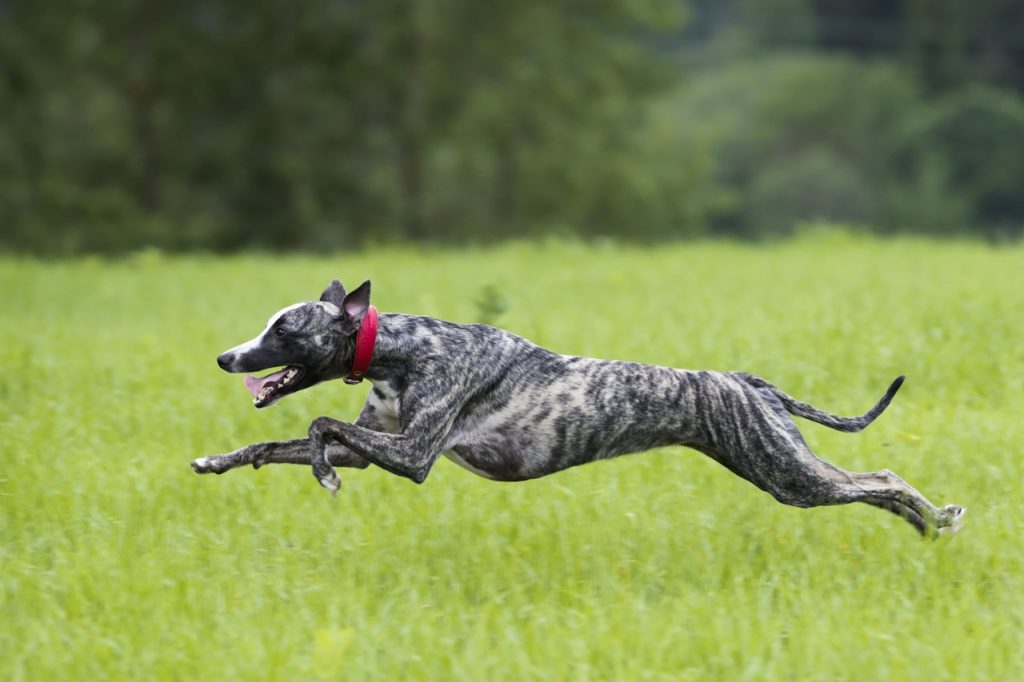For many, the Stark family’s direwolves brought a welcome layer of realism to the show, reminding readers and viewers of the close relationship between man and dog. The direwolves were, in fact, not really wolves at all, though they certainly look wolf-like. They are really a group of Northern Inuit Dogs, a crossbred relative of the Siberian Husky.
What about the real Middle Ages, though? Breeds as we know them today, with the blessing of kennel organizations and tightly defined traits, didn’t exist in the Middle Ages. Still, some breeds are older than others. So, what dog breeds were popular in the Middle Ages?
1. Greyhound
The greyhound is actually one of the oldest breeds of dog. They seem to have originated in the Middle East but they’re staples of European art from the Middle Ages.
Medieval hunting was a complex art. While today hunting is most often performed by one or two people stalking and firing upon their quarry, it was a high sport in the past. Greyhounds were prized for their hunting prowess. Perhaps surprisingly, given their ability to chase down and pin prey, they were only used in the final portion of the hunt.
Just as oddly, while greyhounds were often used for the most violent part of the hunt, they were kept indoors. Their high price notwithstanding, greyhounds tend to be lazy and docile when they’re not hunting, which makes them an excellent pet.
Greyhounds were historically the most prized among animals and they’re the oldest breed still continuing to this day. The tradition of prizing their speed continues as well: greyhounds are the foremost racing dogs in the modern age.
2. Molossus

Jennings Dog: A statue of a Molossus, currently in the British Museum. Roman copy of a Hellenistic bronze original, ca. 2nd century BC. Source: Wikipedia
Mastiffs are large, powerful dogs with a common ancestor. Actually, two breeds were referred to by this name: a hunting dog and a livestock guardian, both of which are the forerunner of modern mastiffs.
The latter has a long history. Their broad head and ferocity made them more dangerous than most predators. This made them ideal as cattle guardians. However, they soon found other uses among humans.
The Romans, for instance, used the Molossus, or a breed close to it, as a war dog. While the uses for these dogs were myriad, the drama of them being released on infantry in packs was among the most famous. Specially trained and equipped with large, spiked collars, the dogs had an imposing presence on the battlefield.
This was more than just psychological warfare. These dogs could force infantry to break ranks and leave them open to a devastating attack from the warriors behind them. Their protective nature also made them a valuable guardian at home.
The breed is splintered, rather than lost, although there is much confusion today due to naming conventions. The closest related dogs are those such as the English Mastiff, 200lb working dogs that amaze people to this day.
3. Corgi
 While the corgi is the epitome of a cute dog, the breed actually has deep roots. The earliest known use of the breed was around 1100 AD and their emergence is steeped in Welsh legend.
While the corgi is the epitome of a cute dog, the breed actually has deep roots. The earliest known use of the breed was around 1100 AD and their emergence is steeped in Welsh legend.
Legend had it that they were ridden by fairies, serving as war steeds before being given to humans for their use. Among humans, of course, they’re known as cattle-herding dogs that do their job with due diligence and a spirited step.
While not as common a practice today, the Corgi often had its tail docked. A docked tail was required for their intended job and a Corgi with the full tail was subject to a luxury tax in the Medieval period.
They’re among the most intelligent dogs around, and their eager-to-please nature makes them easy to train.
The fact that British Royalty keeps them has led to a surge in their current popularity. However, their traceable lineage makes them one of the oldest breeds of European dogs to this day.
4. Swedish Vallhund
This is another short-legged dog with a thousand-year ancestry. The Swedish Vallhund resembles a cross between a Corgi and a Husky but is related to neither and its roots are actually older than either.
The Vallhund may even have played a role in the original breeding of Corgi since they can be dated back to the Viking invasions in England. There’s some uncertainty about the breed’s early origins.
They’re excellent cattle dogs but most are simple pets these days. Those who have worked with them for their original purpose are often amazed at how spry, agile, and intelligent they are. They’re not so far removed from the original stock that they can’t manage a herd of cattle, that’s for sure.
They’re Still Here
While dog breeds as we know them are a new development, the lineage of certain breeds can be traced back to the Middle Ages. These dogs are often among the most popular and healthy breeds as well!
A big thank-you to Emily Green of Doggie Designer for the information in this post!







Fascinating article about breeds of dogs. I have released the Romans used the Molossus as a war dog and released them in packs upon their enemy.
So glad you enjoyed it, Linnea 🙂
Interesting, Nicholas. I like the Corgi’s best out of these breeds. I prefer smaller dogs.
As a bonus, they come with fairies 🙂